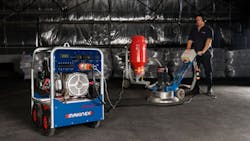RER speaks with Jeff Durgin, global product manager, Makinex, about new generator technology, hurricane season, and the five pieces of information a rental company should know to take proper care of a generator customer.
RER: What is new technologically for your company in generators?
Durgin: Makinex is proud to offer the first of its kind -- portable generators that can produce both three-phase and single-phase power, simultaneously. These small form units produce power via permanent magnets as opposed to traditional copper windings. As a result, we produce as much as 15 percent more wattage per horsepower than conventional copper-wound units. The patented embedded permanent magnet design eliminates the need for complex electronic controls so there is less to malfunction.
Other benefits include:
- Superior motor starting - motor starting capability is 3.5 times rated capacity.
- Single- and three-phase power – The ability to start single- and three-phase motors simultaneously.
- 30 percent smaller footprint – allows us to pack big power in a small package.
- Parallel operations - Run certain model generators in parallel using basic phase matching controls only.
- Three-year warranty on engine and alternator.
Durgin: Make the decision ahead of time if you want to take the risk of stocking units. Keep a close eye on storms and react early. Many companies will wait until the storms are too close to be able to bring in product. Always remember that once the storm hits, it may leave too much damage behind to get units to your location.
As hurricane season begins, what do you as a manufacturer do to prepare?
Durgin: Any good manufacturer will study the weather to try to keep ahead of any major incoming storms, but supply will always be limited to stock on hand and what’s in the pipeline. Lead times on engines and other components can be as long as five months, which can hamper emergency manufacturing, so the key is ramp up before storm season.
Durgin: There are five key pieces of information you will need to know when your customer calls to ask if a generator will power his equipment. Every piece of electric-powered equipment should have a motor plate that will tell you four of them:
- Voltage
- Amperage
- Wattage
- Phase
- Type of load
The first four will be listed on the equipment, the last you have to judge for yourself.
The first thing you will need to do is determine what type of load your customer will be using with the generator. There are two types of loads: resistive and inductive.
Resistive, or reactive, loads are devices that use a heating element and require the same amount of power to start as to run. Examples include light bulbs and appliances such as heaters, toasters, irons and skillets. You will need no additional wattage for startup.
Inductive, or capacitive, loads are devices that use an electric motor and require more wattage for startup than continuous operation. Examples of inductive loads include concrete mixers, submersible pumps and air compressors. As an example, air compressors can require up to five times the running wattage for startup. You will typically allow for an additional 20 percent of running wattage for startup on anything but air compressors.
About the Author
Michael Roth
Editor
Michael Roth has covered the equipment rental industry full time for RER since 1989 and has served as the magazine’s editor in chief since 1994. He has nearly 30 years experience as a professional journalist. Roth has visited hundreds of rental centers and industry manufacturers, written hundreds of feature stories for RER and thousands of news stories for the magazine and its electronic newsletter RER Reports. Roth has interviewed leading executives for most of the industry’s largest rental companies and manufacturers as well as hundreds of smaller independent companies. He has visited with and reported on rental companies and manufacturers in Europe, Central America and Asia as well as Mexico, Canada and the United States. Roth was co-founder of RER Reports, the industry’s first weekly newsletter, which began as a fax newsletter in 1996, and later became an online newsletter. Roth has spoken at conventions sponsored by the American Rental Association, Associated Equipment Distributors, California Rental Association and other industry events and has spoken before industry groups in several countries. He lives and works in Los Angeles when he’s not traveling to cover industry events.
